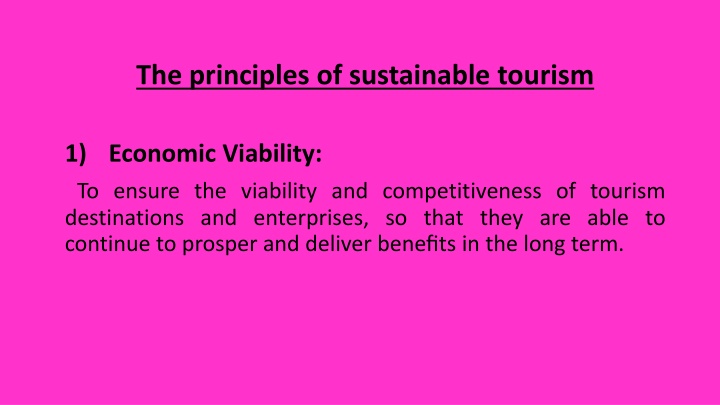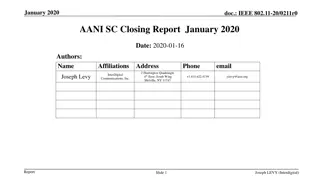
Sustainable Tourism Principles for Long-Term Prosperity
Learn about the key principles of sustainable tourism including economic viability, local prosperity, employment quality, social equity, visitor fulfillment, local control, community wellbeing, cultural richness, physical integrity, biodiversity, and resource efficiency. Embrace a holistic approach to ensure a positive impact on destinations, communities, and the environment.
Download Presentation

Please find below an Image/Link to download the presentation.
The content on the website is provided AS IS for your information and personal use only. It may not be sold, licensed, or shared on other websites without obtaining consent from the author. If you encounter any issues during the download, it is possible that the publisher has removed the file from their server.
You are allowed to download the files provided on this website for personal or commercial use, subject to the condition that they are used lawfully. All files are the property of their respective owners.
The content on the website is provided AS IS for your information and personal use only. It may not be sold, licensed, or shared on other websites without obtaining consent from the author.
E N D
Presentation Transcript
The principles of sustainable tourism 1) Economic Viability: To ensure the viability and competitiveness of tourism destinations and enterprises, so that they are able to continue to prosper and deliver benefits in the long term.
2) Local Prosperity: To maximize the contribution of tourism to the economic prosperity of the host destination, including the proportion of visitor spending that is retained locally.
3) Employment Quality: To strengthen the number and quality of local jobs created and supported by tourism, including the level of pay, conditions of service and discrimination by gender, race, disability or in other ways. availability to all without
4) Social Equity: To seek a widespread and fair distribution of economic and social benefits from tourism throughout the recipient community, including improving opportunities, income and services available to the poor.
5) Visitor Fulfillment: To provide a safe, satisfying and fulfilling experience for visitors, available to all without discrimination by gender, race, and disability or in other ways. 6) Local Control: To engage and empower local communities in planning and decision making about the management and future development of tourism in their area, in consultation with other stakeholders.
7) Community Wellbeing: To maintain and strengthen the quality of life in local communities, including social structures and access to resources, amenities and life support systems, avoiding any form of social degradation or exploitation.
8) Cultural Richness: To respect and enhance the historic heritage, authentic culture, traditions and distinctiveness of host communities. 9) Physical Integrity: To maintain and enhance the quality of landscapes, both urban and rural, and avoid the physical and visual degradation of the environment.
10) Biodiversity: To support the conservation of natural areas, habitats and wildlife, and minimize damage to them. 11) Resource Efficiency: To minimize the use of scarce and non-renewable resources in the development and operation of tourism facilities and services. 12) Environmental Purity: To minimize the pollution of air, water and land and the generation of waste by tourism enterprises and visitors.









